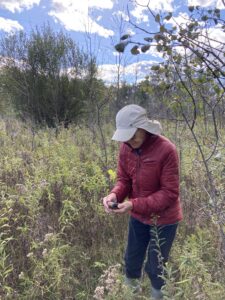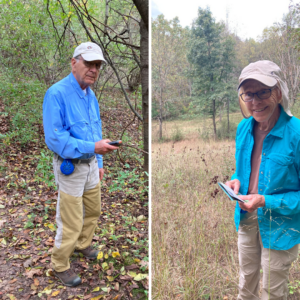By Pete Sandretto
When I wrote a Legacy newsletter article about Geocaching on Legacy’s Preserves in 2014, there were about 1.6 million geocaches in the world. Now there are over 3 million! The hobby continues to grow since being founded in Oregon by a group of folks interested in Geography and Technology, who used the internet and GPS devices to update the older hobby of letter-boxing.
So, what is geocaching? The simple answer: geocaching is a type of global treasure hunt of people looking for hidden stashes of objects1. More specifically, it is an outdoor recreational activity, in which participants use a Global Positioning System (GPS) receiver or mobile device and other navigational techniques to hide and seek containers, called “geocaches” or “caches,” at specific locations marked by coordinates all over the world2.
There are many different types of caches, although most are traditional caches. A traditional cache has a physical presence and has some type of container. The container is found using a GPS enabled device to navigate to a specific set of GPS coordinates where the hidden cache can be found. Some containers can be rather large and some very small. Caches can be anywhere, but there are restrictions on where a cache may be hidden. It cannot be buried, it must not do harm to plants or animals, and must not be in a restricted area. All caches contain a log that must be signed when they are found.
The largest cache I have found was the size of a deep freezer! In fact, it was a camo painted disabled deep freezer, hidden with permission, on private property. The smallest I have found was the size of the tip of my little finger.
Members of the Geocaching community, like me, hide and maintain all of the Geocaches listed on www.geocaching.com. In October 2021, my wife and I helped Legacy Land Conservancy become one of about 361,000 cache owners in the world when we placed a traditional cache in each of Legacy’s six publicly accessible preserves—Woodland, Creekshead, Beckwith, Shatter, Johnson, and Sharon Hills. We joined Washtenaw County Parks and Recreation and the Michigan DNR who have also placed caches in many of their preserves and/or parks. Legacy’s new caches join six other caches that were previously placed in our preserves by other cache owners. Guidelines for placing caches in Legacy’s preserves are located on the Legacy website.
Geocaching is an outdoor, family friendly game that can be enjoyed by all ages. Many caches are kid friendly and some contain trinkets that are there for taking. We hope geocaching will bring new visitors to Legacy’s preserves. It is just one of the ways visitors can enjoy all our preserves have to offer. So next time when you go on a geocaching adventure, check out the ones located in Legacy’s preserves. I know you’ll enjoy the opportunity to hike the trails, watch for birds, spot a deer, and enjoy the wildflowers while you look for hidden treasure!
How do you join the Geocaching Community? It is easy and the basic membership is free. Go to the www.geocaching.com website to sign up. You will need a GPS enabled device. This can be a dedicated GPS device or a smartphone using one of the available Geocaching Apps. These are available for both Android and iPhone devices. The basic Geocaching.com App is free but one can also become a premium member which expands ones geocaching horizons and can make this game even more fun.
To find out more about cache types and container sizes or view more detailed hiding requirements visit www.geocaching.com.
Check out another article on How to Get Started Geocaching
Pete Sandretto and his wife Anita are Legacy Land Conservancy volunteers and active Geocaching community members.
1 Geocaching https://www.nationalgeographic.org/encyclopedia/geocaching/ Retrieved Nov 2021
2 Geocaching https://en.wikipedia.org/wiki/Geocaching Retrieved Nov 2021




 RSS Feed
RSS Feed